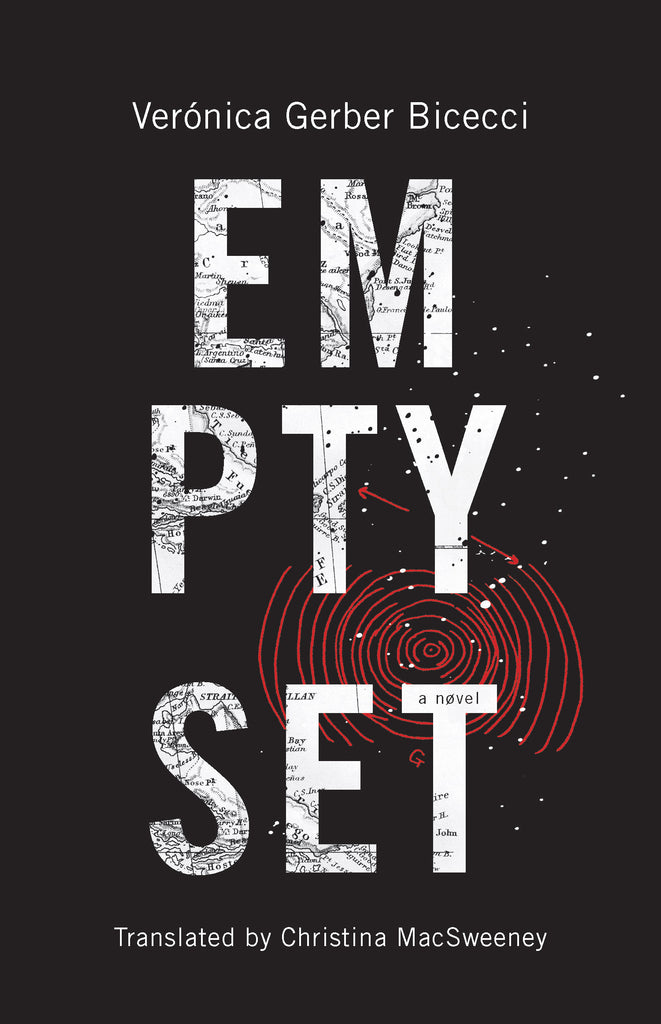A novel by Verónica Gerber Bicecci, translated by Christina MacSweeney
February 6, 2018 • 5 x 7.75 • 232 pages • 978-1-56689-494-4
A Venn diagram for love, Bicecci’s narrator traces and reconstructs her relationships using geometry, ice cores, and tree rings.
How do you draw an affair? A family? Can a Venn diagram show the ways overlaps turn into absences? Can tree rings tell us what happens when mothers leave? Can we fall in love according to the hop-skip of an acrostic? Empty Set is a novel of patterns, its young narrator’s attempt at making sense of inevitable loss, tracing her way forward in loops, triangles, and broken lines.
About the Author
Verónica Gerber Bicecci is a visual artist who writes. In 2013 she was awarded the third Aura Estrada Prize for Literature. She is an editor with Tumbona Ediciones, a publishing cooperative with a catalog that explores the intersections between literature and art.
Christina MacSweeney was awarded the 2016 Valle Inclán Translation Prize for her translation of Valeria Luiselli’s The Story of My Teeth, and her translation of Daniel Saldaña París’s novel Among Strange Victims was a finalist for the 2017 Best Translated Book Award.
Thanks to a 2013 ADA Access Improvement Grant administered by VSA Minnesota for the Metropolitan Regional Arts Council, this title is also formatted for screen readers which make text accessible to the blind and visually impaired. To purchase this title for use with a screen reader please call (612) 338-0125 or email us at info@coffeehousepress.org.
Reviews
Entropy, “Best of 2017: Best Fiction Books”
“Within the deliberately fractured text, themes echo and time folds and unfolds. A spare, artfully constructed meditation on loss, both personal and national.” —Kirkus
“Gerber Bicecci’s experimental novel takes a unique approach to topics like debilitating loneliness, political repression, and epistemological crises.” —Publishers Weekly
“This is a novel to puzzle over as its episodes, which are not chronological, align and create points of reference that allow readers to decipher Verónica’s story just as she herself does.” —Booklist
“A smart story of love and loss with a clever mix of narrative techniques, Empty Set may be an antidote to the current climate of despair.” —Los Angeles Review of Books
“A wonderfully kaleidoscopic novel—so inventive, thought provoking, and offbeat.” —Chicago Review of Books
“Empty Set is a visceral and lucid story and also an art object.” —Literary Hub
“Acutely observant and persistently curious.” —Harvard Review
“Who knew a half-drawn, half-achronological narrative with considerations of time and space and loss and love could be so fun, so easy to devour?” —Atticus Reviews
“Verónica Gerber writes with a luminous intimacy; her novel is clever, vibrant, moving, profoundly original. Reading it made me feel as if the world had been rebuilt.” —Francisco Goldman
“Gerber Bicecci's sentences (and MacSweeney's translation) run as clear as spring water and are a joy to take in, from start to finish.” —Shelf Awareness, starred review
“Empty Set(ES) belongs to the set of Great Fragmentary Novels(GFN), which in turn fits plainly and simply within the set of Great Novels(GN). Verónica Gerber writes with the modesty and care of those who may seem to belong more to the set of Visual Artists(VA) than Writers(W)—each fragment is a precious miniature that exudes subtle, melancholy humor.” —Juan Pablo Villalobos
“I can’t say I’ve ever read anything like it—a novel, sure, but with the spirit (and sometimes the form) of poetry, or linked short stories, along with drawings and a fascinating epilogue on how it was translated.” —Chicago Review of Books
“The pure pleasure of this book is being inside our heroine Vero’s head: the way she Venns relationships like an autodentrochonologist, someone who has serious questions about plywood, but also about exile, Argentina, and the kind of loneliness that accompanies being part of an empty set.” —The Rumpus
“Empty Set is a poignant consideration of displacement, and a haunting search for a set of conditions in which we may feel whole.”—The Riveter
“Empty Set nails a sharp melancholy.” —Matador Review
“In Empty Set, Verónica Gerber Bicecci has found a seemingly new and fascinating way to tell and show us a vital story of modern loneliness, exile, and imagination.” —Words Without Borders
“Consistently innovative and heartrendingly reflective, Bicecci provides a satisfying slice-of-life story despite leaving so much unanswered. . . . Here is a reluctant testament to the fact that beginnings and ends are never as streamlined as we would like them to be; life is riddled with false starts and false summits, and exists only in the border lines that must be drawn to become visible.” —Arkansas International
“A subtle narrative wrapped up in a unique reading experience about loneliness, where the short, fragmented text, and simple, black-and-white drawings echo the subject matter perfectly.” —Remezcla
“An intriguing way of interrogating language.” —Signature Reads
“Dominated by loss, love and exile, this is a novel that can be as frustrating as it is rewarding to unravel, decipher and digest.” —OZY
“Sprinkled throughout with diagrams representing Veronica's relationship to the people and universe around her, Empty Set is a hypnotic portrait of a young woman adrift, but always searching for a new way to express her reality.” —MPR’s The Thread
“As she works through the disappearance of her mother, two heartbreaks, and the archives of a revision-obsessed novelist, Verónica engages in a playful reordering of space on the page: Characters are assigned variables, their relationships to one another expressed through diagrams and patterns. Sketches related to Verónica’s preoccupations (including triangles, Venn diagrams, and forests and ice cores as historical archives) are also dispersed throughout the text as Gerber Bicceci explores the limitations of language and the bittersweet nature of incremental change.”—Unabridged Bookstore
“[A]n experimental mix of prose, diagrams and literary artifacts that is also, somehow, breathlessly plotted.” —Star Tribune
“How do you render negative space, and if you can accurately describe it, is it really negative? Gerber Bicecci revels in these quandaries and pushes them through all manner of expression: visual, mathematical, linguistic.” —Full Stop

